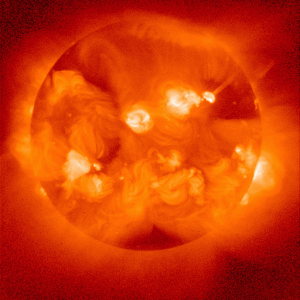This is not a vintage that will go down as one of the best in Tuscany, or at least in Greve in Chianti. Having arrived in Florence in mid January, Ive been able to track the progress of this vintage by living it and speaking to the winemakers. So lets get it goin…
The winter was fairly mild with no extremes in either direction. There was quite a bit of rain from what I can remember, but nothing too harmful. In May, I got to speak with some wine makers and they all agreed that budding was on time and normal. Spring produced average temperatures and rainfall. So far so good. Everything seemed to be going well until August…

Every second the sun produces the same energy as about a trillion 1 megaton bombs! In one second, our sun produces enough energy for almost 500,000 years of the current needs of our civilization.
Scorching temperatures in August with no rain for 30 days hurt the vines. The older vines at Podere Poggio Scalette were able to produce good quality grapes, but the young vines were hit hard. The absence of rain coupled with the rocky, sandy, and well draining soils of the vineyards spelled disaster for some crops of vines.
Finally there was rain in September, which brought some vines back to life, but the rains continued up until harvest. A bout of hail tarnished some of the grapes at Poggio Scalette, but most were untouched. Excess rain was swallowed by the vines and some of the concentration was lost. During harvest, quite a few of the Merlot and Sangiovese vines were littered with mold, so strict selection was a must.

The sun heats up the ocean's surface and water evaporates into the air. When enough moisture is formed clouds appear. Finally, when temperatues get cool enough, the moisture condenses and precipitates in the form of rain. Mountains block the movement of clouds and force them up into the cooler regions of the atmosphere. This is why there is usually arid climate on one side of a range and rainy weather on the other .
Overall, it wasn’t the worst or the best vintage according to Jurij. Due to a large percentage of old vine Sangiovese, there seemed to be enough quality grapes to offset some of the poor. “We will see…”, says Jurij when I asked him how the harvest went. When we took a sample to check the sugar levels from a vat of Sangiovese, the specific gravity tube measured 21 brix which translated to a 13-13.5 abv after fermentation if everything goes right. A sigh of relief echoed through the cellar and sweat was wiped from our face.
Anyone(well maybe not everyone) can make great wine in a great vintage. Great wines made in bad vintages are a testament to the skill of the winemaker and to the quality of terroir. Most people won’t buy wines from bad vintages, but I say go for it. Drinking wines from less than stellar vintages will make you appreciate and pay homage to the fact that nothing can be perfect all the time. I think to truly understand a great wine one must taste the ones which aren’t so great.
Up next: Old Vines vs. New Vines


Leave a comment